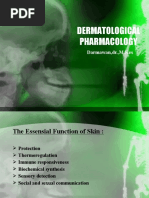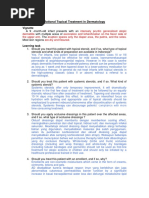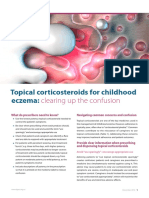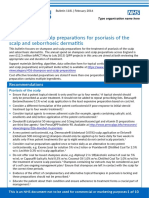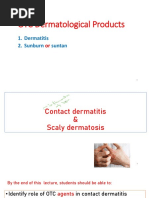Topical Corticosteroids: Highlights
Topical Corticosteroids: Highlights
Uploaded by
Nico Handreas TiantoCopyright:
Available Formats
Topical Corticosteroids: Highlights
Topical Corticosteroids: Highlights
Uploaded by
Nico Handreas TiantoOriginal Title
Copyright
Available Formats
Share this document
Did you find this document useful?
Is this content inappropriate?
Copyright:
Available Formats
Topical Corticosteroids: Highlights
Topical Corticosteroids: Highlights
Uploaded by
Nico Handreas TiantoCopyright:
Available Formats
Topical Corticosteroids
May, 1998 iii
Topical corticosteroids are widely used in the treatment of inflammatory skin conditions. There are over 20 agents to choose from, and an abundance of formulations. Optimal therapy involves careful consideration of the diseases steroid responsiveness, as well as the potency, formulation, application frequency, and cost of the topical steroid.
Highlights
Topical corticosteroids have been classified into 7 potency groups: (Group 1 = Ultra High Potency, and Group 7 = Lowest Potency). Higher potency drugs are useful in more resistant conditions and thick skin areas. Caution should be taken to minimize the potential for side effects. Lower potency drugs are generally preferred on thin skin areas, in young children & infants, and where long term use is required. Many conditions can be managed with low or mid potency agents. A step-down approach from higher to lower potency agents, less frequent application, or to non-steroid emollients is often useful for maintenance therapy. Ointments cause more occlusion and are more effective in dry & hyperkeratinized skin conditions. Relatively low-cost creams/ointments per potency group
Ultra-High: High: Mid: Low: Clobetasol propionate Betamethasone dipropionate Betamethasone valerate Hydrocortisone (Dermovate ) (Diprosone ) (Betaderm ) (Cortate )
PRODUCT SELECTION & USE Potency: Groups 1 7
Topical corticosteroids are classified according to their relative potencies. Seven potency categories (Group 1=Ultra high potency and Group 7=Lowest potency) have been used and described in Tables 3 and 4.1,2 Higher potency agents exert a greater anti-inflammatory activity and carry a greater risk of side effects. Optimizing therapy involves choosing the agent with the lowest potency, which will control the skin condition. Lower potency products are preferred on areas where penetration is high such as the groin, the axillae, and the face. They are also recommended in young children, infants, and the elderly who are more prone to local and systemic side effects. These agents are usually preferred in patients who require long term therapy or application to large areas.3 Higher potency agents are indicated in areas with chronic lesions (plaque psoriasis, lichen simplex, and discoid lupis erythematosus) and areas where skin penetration is poor (such as the elbows, knees, palms, soles).3 After initial control is obtained, maintenance therapy with a lower potency agent is often advisable. Occlusive dressings should be avoided when using Ultra-potent agents.4
conditions may benefit from application of creams during the day, followed by ointments at night to maximize efficacy.
Gels are non-greasy, non-occlusive, non-staining, and quick drying. They are most useful when applied to hairy or facial areas where residue from a vehicle is unacceptable. Caution is warranted if used on the face as most products are potent. Lotions are the least occlusive type of base. They are useful
when large skin areas or skin flexures are affected. They are most useful in conditions where there is acute inflammation or tenderness such as acute contact dermatitis.8 Six ounces should cover the whole body of an average adult. Some lotions, such as scalp lotions, are suitable for hairy areas.
Vehicle Ointments are more potent and effective than other
formulations due to their natural occlusive nature. Ointments are generally preferable in dry, brittle, fissured, scaly, or hyperkeratinized skin areas. They are more effective in treating chronic lesions (psoriasis). They should not be used in areas such as the axilla, groin, or skin folds as their occlusive effect may cause maceration, folliculitis and potential systemic side effects.5 Ointments are particularly useful in young children with infantile atopic dermatitis where dryness of the skin is a particular problem.
Concentration Higher concentrations will increase the
potency, however, this effect seems to plateau. For example, increasing the concentration of hydrocortisone by a factor of 10 results in an increase in potency by a factor of only 4.6
Hydration/Occlusion Application to hydrated skin after
bathing can increase absorption by 4-5 times.7 Occlusion (e.g. plastic wrap) increases absorption by up to 10 times.8 Short term use of occlusion may be useful for severe lesions. If plastic occlusion is used, a maximum of 12 hours in a 24 hour period is recommended to reduce the potential problems of sweat retention, infection, and systemic side effects.9
Creams are often preferred for non-acute dermatoses as they
are cosmetically more acceptable. Proper application requires rubbing fully into the skin in such a way that a residue is not visible after application. Some patients with chronic
Produced by the Community Drug Utilization Program, a St. Paul's Hospital/Saskatoon District Health program funded by Saskatchewan Health. For more information check our website www.sk.ca/RxFiles or contact us C/O Pharmacy Department, Saskatoon City Hospital 701 Queen St., Saskatoon, SK S7K 0M7, Ph. (306) 655-8506, Fax. (306) 655-8804, Email: regierl@sdh.sk.ca
Other factors Various substances can enhance the
penetration and potency of topical corticosteroids. For example, while Diprosone and Diprolene both contain betamethasone dipropionate, the penetration of the drug is enhanced in an optimized base containing propylene glycol resulting in an Ultra-high potency product. Urea and salicylic acid also enhance the potency of a product and can be especially useful in conditions such as psoriasis.
Clarifying Apply sparingly- Patient instructions often
include Apply sparingly. It is important to apply just enough to cover the affected area. Excess quantities are messy and a waste of money. As these products are well tolerated when used appropriately, it is important that the instruction to Apply sparingly does not convey the message that these products are extremely dangerous. An excessive fear of topical corticosteroids may result in poor compliance, and sub-optimal therapy. Before trying a second agent, potential noncompliance (e.g. patient only using OD or PRN) should be assessed if initial therapy appears to fail.
COMPARATIVE SAFETY
The risk of side effects from topical corticosteroids is related to drug potency, duration of therapy, frequency of application and anatomical area. Common side effects are described in Table 1. Dermal atrophy is one of the most notable local side effects. It may occur over several weeks, and is usually reversible. Systemic side effects such as HPA axis suppression are rare but have been seen when the Ultra potent (Group 1) corticosteroids are used. Infants, children, and elderly are at higher risk. Limiting the use of Ultra potent agents to a maximum of 50g/week and a maximum duration of 2 weeks is recommended. Rarely, topical corticosteroids may cause allergic reactions where the allergy is to the steroid itself. In addition, other ingredients (e.g. lanolin, wool alcohols, parabens, antibiotics) in the product may be responsible.10 Allergy testing may be required to select an alternative product.
(Common allergens included in Table 3 comparison.)
Tolerance (Tachyphylaxis) - Tolerance to the antiinflammatory effects of topical corticosteroids can occur. This usually takes several weeks, but can occur earlier. Tolerance should be suspected if an inflammatory skin condition worsens after an initial good response. Tolerance may be prevented by limiting long term application frequency to once or twice daily. It is reversible and can be managed by stopping therapy for a few (~4) days, and then resuming with the same or alternate agent.2 Use of non-steroid bland emollients (See Table 6), following acute management of flare-ups, may also be a useful strategy.12
Mixing of Bases Mixing of bases, or adding ingredients can reduce the potency and shelf-life of some formulations.7 Topical Antibiotic-Corticosteroid Combinations
There are few indications for antibiotic corticosteroid combinations. Many of the products contain neomycin, which is highly sensitizing and should be avoided. When infections necessitate the addition of an antibiotic, systemic treatment is usually preferred. Antifungal corticosteroid combinations are also best avoided except in exceptional circumstances. Use of these combination products is generally discouraged as they are overused, sensitizing, and allow for treatment without diagnosis. Table 2 Topical Antibiotic-Corticosteroid Combinations Cortisporin (Ointment) ($36/30g)
Polymyxin B/Bacitracin(Zinc)/Neomycin/Hydrocortisone 1% Anti-inflammatory (Low-potency)/antibacterial
Table 1 - Side effects of topical corticosteroids
Skin atrophy: Usually occurs after several weeks of treatment. Reversible within 2 months (sometimes longer). Striae: Most common around the groin, axillae, and inner thigh. Usually not reversible, although may fade over time. Telangiectasia: Visible distended capillaries. Often seen on the face, neck, chest. Usually reversible, but can be permanent. Purpura: Bruising occurs with minimal trauma Fine hair growth: Reversible. Acneform/Rosacea like eruptions: Common on the face with high potency agents. Reversible. Hypopigmentation: Especially in dark skinned people. Reversible. Infections: Symptoms of bacterial, fungal, and viral infections may be masked. Conditions may worsen without being recognized. Rebound dermatitis: Can occur with sudden discontinuation. Systemic: (e.g. Hypothalamic-pituitary axis suppression, Cushings syndrome, hyperglycemia, growth retardation in children).11 Rare. Children and elderly are at higher risk. Increased risk with Ultra potent agents, or High potency agents on thin skin areas. Avoid using more than 50g/week or longer than 2-4 weeks treatment with Ultra potent agents.
Kenacomb Mild
(Cream, Ointment)
($25/30g)
Neomycin/Gramicidin/Nystatin/Triamcinolone Acet 0.025% Anti-inflammatory (Mid-potency)/antibacterial/antifungal
Kenacomb/Viaderm-KC
(Cream)
($23/30g)
Neomycin/Gramicidin/Nystatin/Triamcinolone Acet 0.1% Anti-inflammatory (Mid-potency)/antibacterial/antifungal
NOTES FOR OPTIMAL PRESCRIBING Application frequency - Topical corticosteroids may be
applied from OD to QID. For the initial management of acute conditions, BID to QID application may be necessary. Less frequent dosing (OD-BID) is usually adequate for the more potent agents. Since corticosteroids penetrate slowly, the skin serves as a reservoir for the drug. Therefore, frequency of application can often be reduced with repeated application. Once an acute condition is brought under control, OD to BID dosing is often adequate for maintenance therapy and reduces the risk of side effects and tachyphylaxis.
Kenacomb/Viaderm-KC
(Ointment)
($23/30g)
Neomycin/Gramicidin/Nystatin/Triamcinolone Acet 0.1% Anti-inflammatory (High-potency)/antibacterial/anti-fungal
Lotriderm
Cream
($29/30g)
Betamethasone dipropionate 0.05% / Clotrimazole Anti-inflammatory (High-potency)/antifungal NOT suitable for diaper dermatitis due to high potency! 2,6 References available on request
We wish to acknowledge those who have assisted in the development and review of this newsletter: Dr. Z. Tymchak (FM), Dr. M. Jutras (FM) Dr. P.R. Hull (Dermatol.), Linda Suveges PhD, (Pharm.) ), Dr. M. Lyon (Pharmacol.), and the CDUP Advisory Committee. Loren Regier BSP,BA Sharon Downey BSP
The Rx Files - May 1998
Topical Corticosteroids References:
1 2
WHO Model Prescribing Information: Drugs Used In Dermatology, 1995. AHFS (American Hospital Formulary System): Topical Corticosteroids. 1998. 3 Dermatology 3rd Edition, Editors: Moschella SL, Hurley H. 1992. 4 Drug Facts and Comparisons, 1998 Edition. Facts and Comparisons, St. Louis; p3135-3157. 5 Pharmacotherapy: a pathophysiologic approach 3rd Edition. Editors: Dipiro JT, Talbert RL, Yee GC et al. 1997. 6 Giannotti B, Pimpinelli N. Topical Corticosteroids which drug and when. Drugs 1992; 44:65-71. 7 Giannotti B. Current Treatment Guidelines for Topical Corticosteroids. Drugs 1988;36(Supp 5):9-14. 8 Mailback HI. Invivo percutaneous penetration of corticosteroids in man and unresolved problems in the efficacy. Dermatologica. 1976;162:11. 9 Bond CA. Dermatotherapy in Applied therapeutics. Editors: Koda-Kimble M and Young LY. 1997. 10 Weltfriend S, Maibach H. Skin Diseases in Averys Drug Treatment 4th Ed., Adis Int. 1997, p631-682. 11 Weston W. Topical steroids in children. The Can J of Derm. 1994;6(4):640-644. 12 Zug KA, McKay M. Eczematous Dermatitis: a practical review. American Family Physician. 1996;54(4):1243-1250.
Produced by the Community Drug Utilization Program, a St. Paul's Hospital/Saskatoon District Health program funded by Saskatchewan Health. For more information check our website www.sk.ca/RxFiles or contact us C/O Pharmacy Department, Saskatoon City Hospital 701 Queen St., Saskatoon, SK S7K 0M7, Ph. (306) 655-8506, Fax. (306) 655-8804, Email: regierl@sdh.sk.ca
You might also like
- Dermatological PharmacologyDocument25 pagesDermatological Pharmacologyborneo225100% (1)
- Hospital Policy ManualDocument26 pagesHospital Policy ManualBasant GuptaNo ratings yet
- Neonatal Pneumonia Case StudyDocument2 pagesNeonatal Pneumonia Case StudyAngel Villamor0% (1)
- Medical Certificate 2Document2 pagesMedical Certificate 2Aditeya Shukla100% (1)
- Flutivate Skin Cream 1. Generic Name: For The Use Only of Registered Medical Practitioners or A Hospital or A LaboratoryDocument11 pagesFlutivate Skin Cream 1. Generic Name: For The Use Only of Registered Medical Practitioners or A Hospital or A LaboratoryManas MishraNo ratings yet
- Day 11 Rational Topical Treatment in Dermatology: VignetteDocument2 pagesDay 11 Rational Topical Treatment in Dermatology: VignetteHananya ManroeNo ratings yet
- Flutivate e CreamDocument9 pagesFlutivate e Creamseema sharmaNo ratings yet
- dermovate_cream_drDocument10 pagesdermovate_cream_drmirgan.agronNo ratings yet
- Activity 10 CPP LabDocument8 pagesActivity 10 CPP Labmohammad abdusalimNo ratings yet
- Flutibact Skin OintmentDocument12 pagesFlutibact Skin OintmentSowndarya100% (1)
- eumosoneDocument8 pageseumosoneFlamingoNo ratings yet
- Cutivate Cream gds15 Ipi05 01Document4 pagesCutivate Cream gds15 Ipi05 01meiren ongNo ratings yet
- Topical SteroidsDocument59 pagesTopical SteroidsdrbhaveshpNo ratings yet
- PHARMACOLOGY OF MEDICATIONS FOR SKIN DISEASE 2021 Lecture - DR NanaDocument39 pagesPHARMACOLOGY OF MEDICATIONS FOR SKIN DISEASE 2021 Lecture - DR Nanawilliam atmadjiNo ratings yet
- General Considerations For Topical PreparationsDocument6 pagesGeneral Considerations For Topical PreparationsOccamsRazorNo ratings yet
- Dermovate Cream and Ointment gds16 Ipi10 01Document4 pagesDermovate Cream and Ointment gds16 Ipi10 01meiren ongNo ratings yet
- Topical StreroidsDocument49 pagesTopical StreroidsFrancis ChegeNo ratings yet
- EczemaDocument5 pagesEczemaJayson TrajanoNo ratings yet
- Dermatologic Disorders Part 1Document53 pagesDermatologic Disorders Part 1Marc Ericson GlodoveNo ratings yet
- Pharmacology Block DMS 2016Document43 pagesPharmacology Block DMS 2016hudaNo ratings yet
- eumosone-mDocument11 pageseumosone-mbhardwajbhavya378No ratings yet
- Betnovate C Skin CreamDocument11 pagesBetnovate C Skin CreamRetik KoulNo ratings yet
- DermatologyDocument2 pagesDermatologydyansaNo ratings yet
- Topical FormulationsDocument5 pagesTopical FormulationsSandeep GargNo ratings yet
- Topic - Therapeutic Guidelines-Psoriasis Skin RashDocument5 pagesTopic - Therapeutic Guidelines-Psoriasis Skin RashchaitaliNo ratings yet
- Acne Course - NotesDocument11 pagesAcne Course - NotesMartin MaherNo ratings yet
- DECLOBANDocument2 pagesDECLOBANCamilleNo ratings yet
- L3 Topicals Therapy in DermatologyDocument61 pagesL3 Topicals Therapy in DermatologyOmar Hamwi100% (1)
- Eczema: Starship Children's Health Clinical GuidelineDocument10 pagesEczema: Starship Children's Health Clinical GuidelineI Wayan Tri Sulaksana GiriNo ratings yet
- Acne VulgarisDocument5 pagesAcne VulgarisVinh Đỗ ĐìnhNo ratings yet
- Adults, Elderly and Children Over 1 YearDocument7 pagesAdults, Elderly and Children Over 1 YeardindaikaputriNo ratings yet
- Calcineurin Inhibitors Aug 2012 - Lay Reviewed Jun 2012Document4 pagesCalcineurin Inhibitors Aug 2012 - Lay Reviewed Jun 2012BogdanNo ratings yet
- Topical Corticosteroids For Childhood Eczema:: Clearing Up The ConfusionDocument6 pagesTopical Corticosteroids For Childhood Eczema:: Clearing Up The ConfusionRed DiggerNo ratings yet
- Jurnal Cradle 4Document10 pagesJurnal Cradle 4Dewi NurfadilahNo ratings yet
- Rosacea Treatment GuidelinesDocument3 pagesRosacea Treatment GuidelinesdandelionsNo ratings yet
- Emollients Full GuidelineDocument8 pagesEmollients Full GuidelineLegolas gantengNo ratings yet
- Topical TreatmentsDocument9 pagesTopical TreatmentsHerold23No ratings yet
- Acne Vulgaris-1Document7 pagesAcne Vulgaris-1amanabduwahabNo ratings yet
- Atopic+Dermatitis+SDCDocument55 pagesAtopic+Dermatitis+SDChanalexianNo ratings yet
- Derma ADDocument49 pagesDerma ADFatima Marwa Teo MaghinayNo ratings yet
- Ecozone 004Document2 pagesEcozone 004Indah GalinggingNo ratings yet
- Skin P2 and CNS: Dr. Marwan Al-ZubeidyDocument19 pagesSkin P2 and CNS: Dr. Marwan Al-ZubeidyToumany FofanaNo ratings yet
- Topical CorticosteroidsDocument3 pagesTopical CorticosteroidsArsyil96No ratings yet
- Topical TX For PsoriasisDocument24 pagesTopical TX For PsoriasisColeStreetsNo ratings yet
- Atopic Dermatitis (Eczema) - Diagnosis and Treatment - Mayo ClinicDocument1 pageAtopic Dermatitis (Eczema) - Diagnosis and Treatment - Mayo ClinicHarry LeNo ratings yet
- Tinea VersicolorDocument2 pagesTinea VersicolorAchep WahyuNo ratings yet
- OTC Dermatological Products: 1. Dermatitis 2. Sunburn SuntanDocument30 pagesOTC Dermatological Products: 1. Dermatitis 2. Sunburn SuntanEman AlshaikhNo ratings yet
- Pendahuluan Swamedikasi Penyakit KulitDocument13 pagesPendahuluan Swamedikasi Penyakit Kulitanis dwi astutiNo ratings yet
- Zinc Oxide Topical PasteDocument33 pagesZinc Oxide Topical PasteEj RoblezaNo ratings yet
- Psoriasis Group 3-2Document10 pagesPsoriasis Group 3-2kernig43No ratings yet
- Dermatological Pharmacology FKDocument12 pagesDermatological Pharmacology FKAbel MncaNo ratings yet
- Dermatologic PharmacologyDocument88 pagesDermatologic PharmacologyAlunaficha Melody Kirania100% (1)
- Para Clase Práctica SemisólidosDocument4 pagesPara Clase Práctica SemisólidosYisel NavarroNo ratings yet
- Topical CorticosteroidsDocument1 pageTopical CorticosteroidsDavid HosamNo ratings yet
- Formulation and Evaluation of Cream Containing: Antifungal Agents, Antibacterial AgentsDocument9 pagesFormulation and Evaluation of Cream Containing: Antifungal Agents, Antibacterial Agentsyogesh ruhalNo ratings yet
- Eczema and DermatitisDocument20 pagesEczema and DermatitisVenom LyteNo ratings yet
- Psoriasis Management May 2018Document13 pagesPsoriasis Management May 2018ShamlazaghNo ratings yet
- Betamethasone Valerate Cream 0.1% W/W Betamethasone Valerate Ointment 0.1% W/WDocument6 pagesBetamethasone Valerate Cream 0.1% W/W Betamethasone Valerate Ointment 0.1% W/WAgapa Yagamo GamikaNo ratings yet
- Pyoderma DogsDocument7 pagesPyoderma DogstorqtechNo ratings yet
- Topical Steroids (Sep 19) PDFDocument7 pagesTopical Steroids (Sep 19) PDF1234chocoNo ratings yet
- Hyper-Pigmentation Of The Skin A Simple Guide To The Condition, Treatment, And Related ConditionsFrom EverandHyper-Pigmentation Of The Skin A Simple Guide To The Condition, Treatment, And Related ConditionsRating: 5 out of 5 stars5/5 (3)
- No. 3 - June 2018 - Some Considerations About EMDR and PsychosisDocument4 pagesNo. 3 - June 2018 - Some Considerations About EMDR and PsychosisYolanda BallesterosNo ratings yet
- Anatomy & Physiology (Written)Document4 pagesAnatomy & Physiology (Written)MaQsud AhMad SaNdhuNo ratings yet
- Components of Mental Status ExaminationDocument5 pagesComponents of Mental Status ExaminationDesta FransiscaNo ratings yet
- Burn RehabilitationDocument5 pagesBurn Rehabilitationdrng48No ratings yet
- Diabetes Septic CarbuncleDocument25 pagesDiabetes Septic CarbuncleLouie George Neri0% (1)
- How To Manage Heart Failure in Primary Health Care Prof. Djoko Soemantri MD FIHADocument43 pagesHow To Manage Heart Failure in Primary Health Care Prof. Djoko Soemantri MD FIHAIvor Wilopo100% (1)
- Pre-Employment Medical Examination Cum Fitness CertificateDocument7 pagesPre-Employment Medical Examination Cum Fitness CertificateAshutosh PathakNo ratings yet
- ORE DrugsDocument4 pagesORE DrugsKhalid G. AzouniNo ratings yet
- Breakthrough SeizureDocument14 pagesBreakthrough SeizureReda Al BadryNo ratings yet
- Nader Kamangar, MD, FACP, FCCP FCCM, FAASM, Associate Professor of Clinical Medicine, UniversityDocument7 pagesNader Kamangar, MD, FACP, FCCP FCCM, FAASM, Associate Professor of Clinical Medicine, UniversitynurulfitriantisahNo ratings yet
- Teenage PregnancyDocument60 pagesTeenage PregnancyChristopher John Aguelo67% (3)
- Pharyanx IDocument28 pagesPharyanx Ij8bhfmc6s9No ratings yet
- Management of Gestational Diabetes Mellitus With.4Document7 pagesManagement of Gestational Diabetes Mellitus With.4ShefaNo ratings yet
- A.duodenale PPT Final DraftDocument21 pagesA.duodenale PPT Final Draftonkarabile thebeNo ratings yet
- MD Pharmacology Question Papers 2019-06-17 11.48.23Document11 pagesMD Pharmacology Question Papers 2019-06-17 11.48.23Vijendra R100% (1)
- Edmark 2014Document9 pagesEdmark 2014Juampi FerrariNo ratings yet
- Rickets PDFDocument39 pagesRickets PDFLidia Iglesias SiglerNo ratings yet
- Resource Mapping - TemplateDocument10 pagesResource Mapping - TemplateFranz SalazarNo ratings yet
- HagarDocument28 pagesHagarSandeep KannegantiNo ratings yet
- Anatomy - Chapter 3 Tissues WSDocument6 pagesAnatomy - Chapter 3 Tissues WSOlalekan OyekunleNo ratings yet
- 5.postural Drainage TherapyDocument23 pages5.postural Drainage Therapyrobcaleb123No ratings yet
- Hematological Study of Piper Guineense On Adult Female Wistar RatDocument39 pagesHematological Study of Piper Guineense On Adult Female Wistar Ratmbah anthonyNo ratings yet
- Molecular Epidemiologic Analysis of Enterococcus FaecalisDocument8 pagesMolecular Epidemiologic Analysis of Enterococcus FaecalisoinkNo ratings yet
- Chronic PancreatitisDocument51 pagesChronic PancreatitisAli Nawaz khanNo ratings yet
- Surveys: Medicolegal Claims Against Anaesthetists: A 20 Year StudyDocument12 pagesSurveys: Medicolegal Claims Against Anaesthetists: A 20 Year StudyNguyen Duy ThanhNo ratings yet
- Hodgkin's LymphomaDocument18 pagesHodgkin's LymphomaWilson Tiang Ko-PingNo ratings yet
- Module 3 AsepsisDocument14 pagesModule 3 Asepsisjhoyjhoy779No ratings yet
